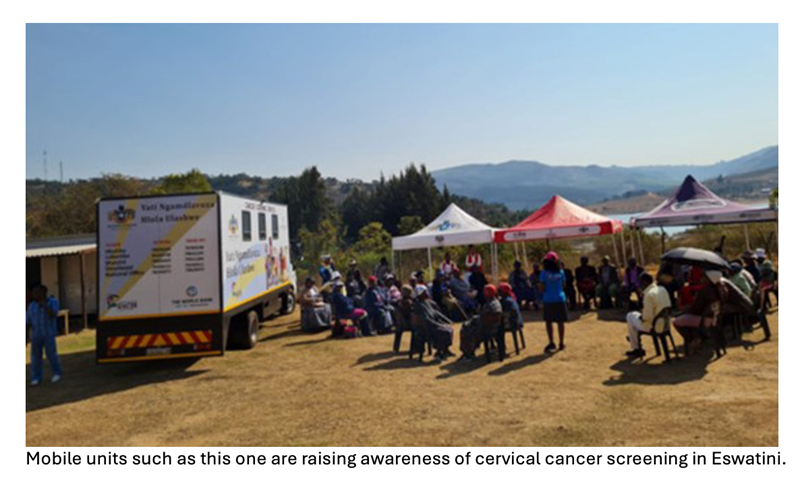Eswatini Working to Finalize the Country’s First Radiotherapy Center
 Experts appointed by the International Atomic Energy Association (IAEA), the World Health Organization (WHO) and the International Agency for Research on Cancer (IARC) to carry out an imPACT Review in Eswatini, found that the country has finalized a strategic funding proposal, enacted a Nuclear and Radiation Safety Law, and surveyed potential sites for geotechnical suitability.
Experts appointed by the International Atomic Energy Association (IAEA), the World Health Organization (WHO) and the International Agency for Research on Cancer (IARC) to carry out an imPACT Review in Eswatini, found that the country has finalized a strategic funding proposal, enacted a Nuclear and Radiation Safety Law, and surveyed potential sites for geotechnical suitability.
The mission in August 2024 built on a 2017 imPACT Review that laid the foundations for the development and implementation of the National Cancer Control Plan 2019-2023.
Other achievements since that period include the establishment of the National Cancer Control Unit at the Ministry of Health; the introduction of human papillomavirus (HPV) vaccination into the National Immunization Programme; the recruitment of a clinical oncologist and a medical physicist; the creation of a 60-bed chemotherapy unit operating at Manzini Government Hospital; and the development of a draft Nuclear Bill that currently awaits approval by the National Assembly.
Of Eswatini’s 1.2 million people, over 1000 were diagnosed with cancer in 2022, and close to 700 people died of the disease (Globocan). Cancers of the breast, cervix and prostate accounted for more than 50 per cent of these cases. With no radiotherapy services available within the country, the government currently helps patients access this treatment in South Africa using the country’s Phalala Medical Referral Fund.
“This solution is not sustainable,” said Mduduzi Matsebula, Eswatini’s Minister of Health. “Our government is working hard to build a first radiotherapy facility so that our patients can be treated at home, committing already one million euros to the success of this project,” he added.
In support of this goal, Eswatini is in the process of finalizing a strategic funding document to mobilize domestic and international funds. The imPACT Review mission was an opportunity to update key sections of this ‘bankable’ document, including the country’s cancer profile and available infrastructure, as well as requirements for equipment and human resources, and estimated preliminary costs.
The development of strategic funding documents is one of the ways the IAEA provides support to countries. These documents come under the ownership of the country, and are validated by the IAEA through technical and economic feasibility assessments. They provide comprehensive insights into the requirements of proposed projects – tailored to the country’s cancer profile, control plan, existing physical infrastructure and human resource capabilities. They help government decision-makers and funding partners to identify the needs and funds required to set up a radiotherapy facility. In the case of Eswatini, the bankable document represents an important preliminary step towards the establishment of the country’s first radiotherapy center.
During the mission, the imPACT Review team visited six health facilities across the country and performed a siting analysis for the new radiotherapy centre location. Experts provided inputs on the proposed plan and conducted preliminary observations on its geotechnical suitability. The team also met Members of Parliament to discuss financing and cancer control regulatory frameworks.
With eight of the 12 international experts coming from Africa, the mission was a clear demonstration of regional expertise and South-South collaboration. The imPACT Review team also explored opportunities for synergies with stakeholders involved across the cancer control continuum, including the Clinton Health Access Initiative, United Nations Population Fund (UNFPA), the United Nations Children’s Fund (UNICEF) and the World Bank.
With cervical cancer accounting for more than 50 per cent of all cancers affecting women diagnosed in 2022, this was another priority area of focus during the mission. “The imPACT Review provided a platform for us to explore potential synergies in strengthening cervical cancer control under the Global Cervical Cancer Elimination Initiative,” said Susan Tembo from the WHO Country Office. “We are working closely with the Government of Eswatini and other partners to enhance the health system’s capacities to comprehensively address the growing cancer burden, including the development of a national roadmap for eliminating cervical cancer,” she added.
On the last day of the mission, the Principal Secretary for Health, WHO Country Representative, Director of Health Services, implementing partners and all Ministry of Health program managers were debriefed on the imPACT Review preliminary findings and recommendations. These recommendations are expected to contribute to the development of future technical cooperation projects and to support potential participation in the IAEA’s Rays of Hope initiative.
“I see great hope for the socio-economic development of Eswatini,” said Shaukat Abdulrazak, the Director for Africa in the IAEA’s Technical Cooperation Department. “The recent signing of the Country Programme Framework for the period 2024–2029 is an opportunity to align IAEA technical cooperation efforts with the Eswatini National Development Plan and the promulgation of the nuclear law. In addition, with Eswatini formally requesting to join two flagship IAEA initiatives – Rays of Hope and Atoms4Food – the IAEA will continue to support the Kingdom for the establishment of the first public radiotherapy facility on the one hand, and food safety and security on the other,” he added.

